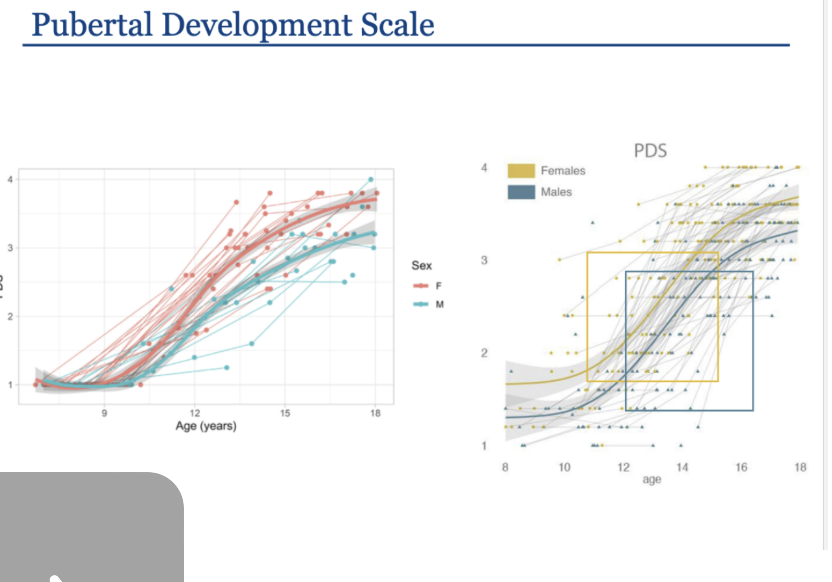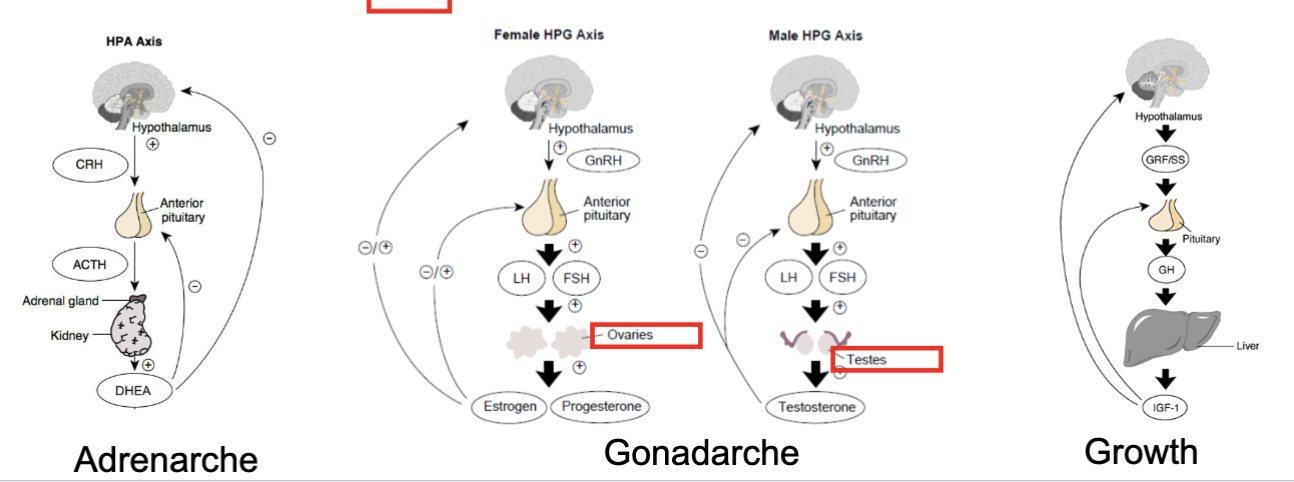Thinking Child - Final Exam
1/33
There's no tags or description
Looks like no tags are added yet.
Name | Mastery | Learn | Test | Matching | Spaced |
|---|
No study sessions yet.
34 Terms
Primary and secondary characteristics of Puberty
Primary characteristics → reproductive capabilities, testosterone, fetus, eggs, also menarche: first period
Secondary characteristics → body hair, muscle mass, breast development, height…
Puberty as a process
Thelarche refers to the onset of breast development, often the first sign of puberty in girls
Spermarche refers to the onset of sperm production and first ejaculation in males

Pubertal Development Scale
Correlation between PDS (pubertal dimensions) and age, but not linear
A steep increase at around age 12, but the growth rate seems to occur quicker for females in red, while males show a slower one (same thing on the right graph)
Quickest acceleration for females in the yellow box, and males in blue box, which occurs at different time periods
Age and puberty are related, but not 100% correlated
Each dot is a measurement in an individual person
What is the body as a three part control system?
Brain: Hypothalamus → mostly influenced in puberty (Boss who sends out messages)
Pituitary gland: messenger center (manager who then passes it on to the different body parts)
Production centres like gonads, which are ovaries in girls and testes in boys → receive the messages and then they start making hormones so the body can change as you observe it.
When puberty begins, this system is basically like turned up and the volume starts to increase. Mostly during sleep at first.
→ When these messengers reach the production centres, the ovaries start making estrogen, this causes the breast to develop and other changes and in males the testes start making testosterone, which grows the penis and testes.
How does the feedback loop work?
Hormones also send messages back to the brain. In Females, this leads to menstrual cycle. In males, it leads to sperm production. The loop is slightly different depending on whether its cyclical or continuous (males its continuous)

What are the three main phases?
Adrenarche
Before gonadarche, which we typically think of the start of puberty, the adrenal glands become more active. Earliest stage of puberty.*
Age is linked to an increase in adrenal androgens during this period, hormone secretion in the HPA axis
The adrenal glands make a milder version of sex hormones, and this contributes to the initial development of things like pubic hair, sweat glands, and body odour.
DHEA is an adrenal androgen produced by the adrenal glands and it's a precursor to those primary sex hormones.
Gonadarche
Considered primary puberty, and this occurs through the HPG axis, the hypothalamic pituitary gonadal axis.
Characterized by the maturation of primary sex characteristics. When we think about those secondary sex characteristics that's often coming through because of that HPA access activation. Occurs between 8 and 14 for females and 9 and 15 for males.
Growth
distribution of growth hormones → growth spurt.
When the pituitary gland releases growth hormones, the liver is the primary organ to respond, by producing insulin-like growth factor one. The liver essentially amplifies growth signals from puberty
So sex hormones that are activated during gondarche facilitate this growth process. If you don’t have normal liver functioning, growth will be significantly stunted.
It’s also the system that stops growing, at some point, the system has to say enough.

Oestrogen (3 main types)
There are three main types of oestrogen: estrone (menopause), estradiol (puberty), and estriol (pregnancy)
Estradiol → most potent and abundant oestrogen during women's reproductive years
Both males and females show changes in testosterone and estradiol during puberty
Hormones
DHEA: adrenal hormone that rises during adrenarche, around ages 6–8, preceding the visible signs of puberty. A precursor to androgens and oestrogens and is thought to contribute to brain maturation and increased emotional reactivity. During puberty, DHEA levels increase steadily and are associated with early pubertal changes such as body odour and the development of pubic hair.
2. Testosterone: the primary male sex hormone but is also present in lower levels in females. During puberty, testosterone levels rise sharply in boys and more moderately in girls. It plays a key role in the development of secondary sexual characteristics and has been linked to changes in reward sensitivity and risk-taking.
3. Estradiol: the primary oestrogen hormone and increases substantially during puberty, particularly in females. Its rise is associated with breast development, regulation of the menstrual cycle, and emotional processing. Estradiol has been linked to increased sensitivity to social and emotional stimuli and contributes to changes in mood and social behaviour.
4. Progesterone: a steroid hormone involved in the menstrual cycle and reproductive functions. Its levels begin to rise during the later stages of puberty in females, especially after menarche. Thought to influence emotional regulation and stress responses, although its cognitive effects are less studied than those of estradiol.
Pubertal Dimensions: Timing, Tempo, Status (measuring)
Timing: relative to population norms
Tempo: rate of change
Status: what stage of puberty